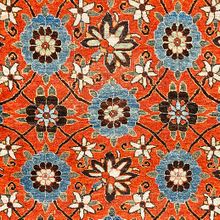Varamin Rug
| Varamin Rug | |
|---|---|
 Design of Varamin Rug (Rugman) | |
| General information | |
| Name | Varamin Rug |
| Original name | قالي ورامین |
| Alternative name(s) | Varamin Carpet |
| Origin | |
| Category | Village |
| Technical information | |
| Common designs | Vagireh, Afshan, Shah Abbasi |
| Common colors | Blue, Navy Blue, Cream, Red, Beige, Green |
| Dyeing method | Natural, Synthetic |
| Pile material | Wool |
| Foundation material | Cotton |
| Knot type | Asymmetrical (Persian), Symmetrical (Turkish) |
Veramin is a small town near Tehran, in north central Iran. The rugs made in Veramin have a very distinct style, and a rug of such type always stands out in a bunch because of its unique pattern. The famous pattern of most Veramin rugs is an allover pattern, consisting of floral elements throughout the field in an organized symmetrical way. There isn't a medallion in the center, and other than the border, the rug comes across subtle. The main colors are red and burgundy, navy blue, forest green, and accents of other minor colors. The quality in Veramin rugs is absolutely incredible. These rugs are made with a very tight weave and with only the best wool and dyes. Generally a Persian rug from Veramin will last a very long time and it will only increase in value with age.
History
Varamin, also spelled Veramin in the trade, is a city in the Tehran Province of north central Iran. Varamin rugs are categorized in the trade under two time periods, the last quarter of the nineteenth century and 1920s to the present day.
Early Varamin rugs were woven by the Shahsavan tribe, which moved south from northwestern Persia and settled in Varamin.These rugs are geometric and sometimes have Minakhani (rosette-linked trellis) motifs with tribal design elements in the field. Other pieces are more strongly geometric, with abstract small medallions and other devices derived from flatwoven mum rugs. The rugs have a wool foundation and a wool pile. The Turkish (symmetric) knot is employed. Early Varamin rugs have deep red or dark blue coloration for the background. These colors are interchangeable for the borders. The formats range from tribal items to rugs up to nine feet by six feet as well as runners. They are woven in grade qualities of good to fine.
By the 1920s, Varamin weavers switched to a city style with a cotton foundation and a wool pile, applying the Persian (asymmetric) knot. The floral, allover style was mainly woven with several traditional designs, such as the Minakhani, Zili Sultan, Herati (fish), Moharamat (stripes), and palmette with leaves and vines. Some of these Varamin carpets are marketed as Tehran carpets because of their similar weaving techniques and the close proximity of the two cities. Varamins characteristically have a light background color such as ivory, light blue, light green, or gold. This color choice distinguishes Varamin weavings from those produced in cities such as Kashan and Khorasan. This change was marketed successfully domestically and for export. Traditional reds and blues were also used for the field.These colors are interchangeable for the border as well. This Varamin type is woven in sizes ranging from approximately five feet by three feet to room sizes. The rugs are made from very good to fine in grade quality.
During the late twentieth century, some Varamin weavers incorporated new designs in addition to weaving traditional styles in order to meet world market demand. These rugs are finely woven, featuring a silk or wool pile.[1]
See also
| Search for Varamin Rug on Wikipedia. |
References
- ↑ Moheban, 2015, 605-606
Bibliography
- Abraham Levi Moheban. 2015. The Encyclopedia of Antique Carpets: Twenty-Five Centuries of Weaving. NewYork: Princeton Architectural Press.